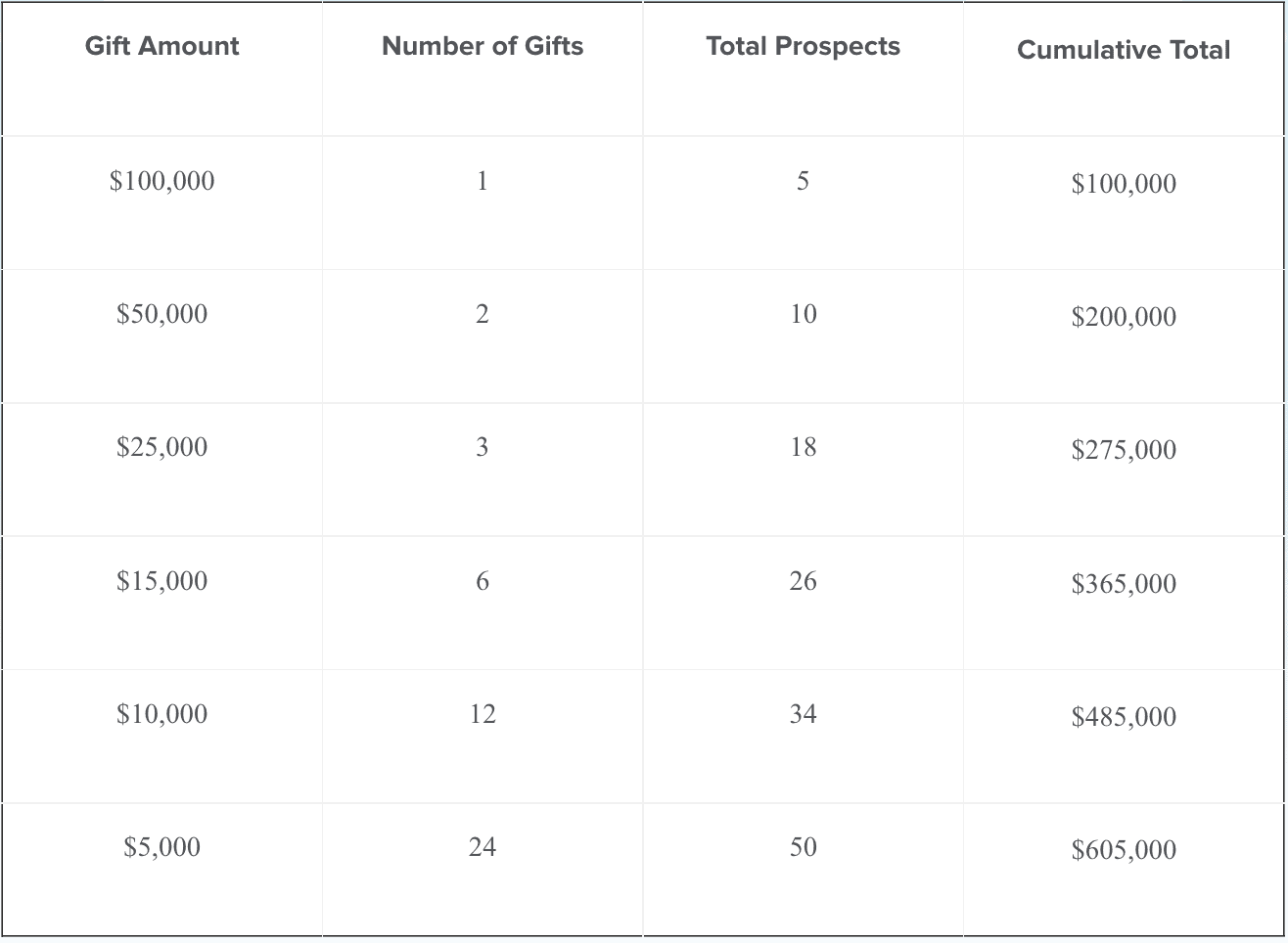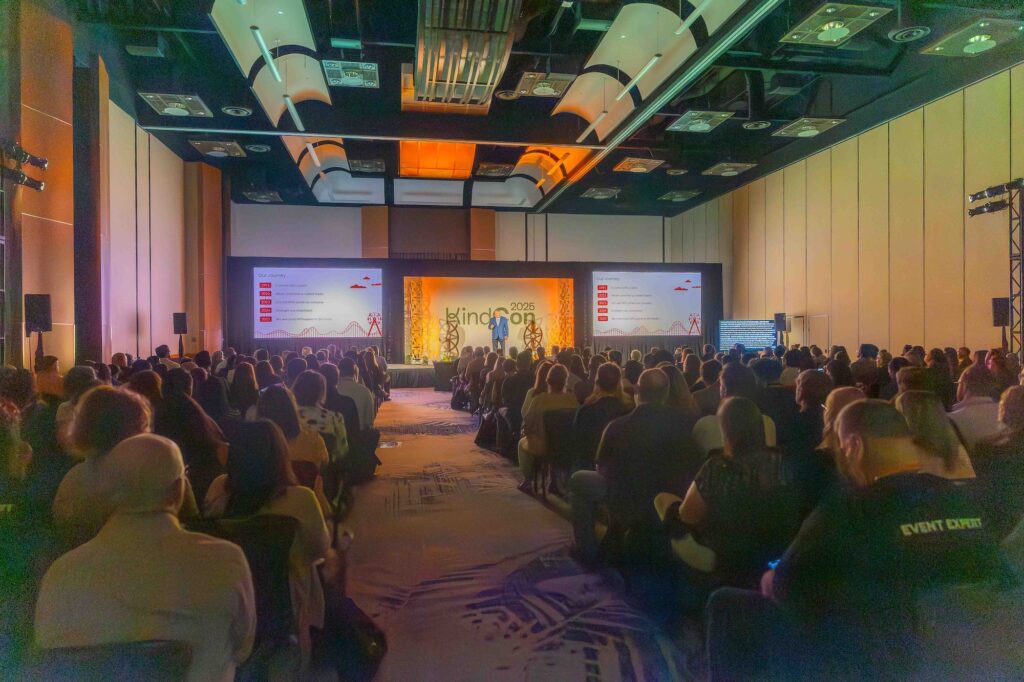
With accurate prospect research on your side, you better ensure the short- and long-term success of your nonprofit organization’s fundraising efforts. A gift range chart is yet another tool at your disposal that can help you make the most of every ask.
To find out how iWave can help you build a reliable gift range chart to streamline your fundraising efforts, schedule a free demo or assessment today!
What Is a Gift Range Chart?
Though most often used as part of a feasibility study during a capital campaign, a gift range chart is adaptable and can be used for a variety of fundraising types. When it comes to executing a fundraising campaign, the more you know, the more power you have to course correct along the way.
In general, a gift range chart is structured like a pyramid with larger giving amounts at the top.
Though higher giving levels tend to demand significant resources, opening up efforts to the mid and lower ranges creates a well-rounded strategy that will likely yield more gifts.
The more strategic you are from the beginning, the more efficient your campaign will be. Your gift range chart will enable you to determine how much to ask for and from whom, as well as help you narrow down your short list of major gift prospects.
Combining your gift range chart with reliable wealth screenings will also give you the necessary insights to make the right gift ask every time. iWave can help here with our personalized onboarding process and unlimited client support.
Getting Started
When conducting your fundraising feasibility study, let your gift range chart guide your efforts. As you begin to plan out your fundraising campaign, proceed with the following steps:
- Determine if your current goal is attainable and make any necessary changes.
- Set distinct giving levels, along with specific data-driven fundraising asks.
- Dig into the details of what it will take to reach your fundraising goal.
With a clearer sense of how many prospects you must reach and how much you need to ask for from each one, you’ll be well on your way to building a winning fundraising strategy.
How to Organize Your Gift Range Chart
Your gift range chart will be split into distinct giving levels, such as major, midsize, and smaller gifts. The major gifts sit at the top of the gift range chart and will generally have the smallest number of donors.
Moving downward, at the midsize level you should aim for a greater number of donors. Finally, your smallest giving level will include the largest number of donors. Since less people are capable of giving major donations, you’ll need to make up for this by gathering additional smaller contributions.
The next segment of your gift range chart will be the specific range you’ll ask for from each giving level. It will look something like this:

For convenience and quick analysis, the cumulative total in the final column adds everything up as you go along.
Gift Range Chart: Quick Tips
The following are some tips to be mindful of as you build your chart:
- Build Downwards: Start with your top-level gift and build your chart down from there. Each new gift level should cut the previous gift level in half and the number of donors and prospects should increase.
- Tailor to Your Campaign: Each fundraising effort is unique. How you jumpstart an annual campaign is bound to differ from the start of a capital campaign, so make sure you’re changing up your strategy and chart to match. When it comes to your gift range chart, one size does not fit all.
- Have Back-Ups: As you can see in the sample chart we put together, there are way more prospects than there are actual donors. You want to be fully prepared for a range of situations. By having more prospects, you’re increasing the possibility that you achieve your goals. These charts are meant to change, so receiving more donors than expected can empower your nonprofit even more.
- Cast a Wide Net: Always enter a gift ask with a high offer, anticipating counteroffers and an open discussion. Prospects can always move around your chart and counter with a lower offer that moves them into a different tier. This can still have a great, positive impact on your fundraising campaign, so make sure you’re open to changes.
Adjusting Gift Range Charts for Different Campaigns
Keep in mind that the size of your nonprofit, the scope of your fundraising goal, and the campaign you are running will impact the structure of your unique gift range chart.
Particularly for larger campaigns, expect about 80% of your total fundraising to come from merely 20% of donors. As a rule of thumb, you’ll want to cut each gift amount in half as you move down your gift range chart. Simultaneously, as you decrease the gift amount, you’ll double and then triple the number of donors at each level.
Some examples of how you might tailor your gift range chart to meet the demands of distinct campaigns include:
Crowdfunding
Crowdfunding campaigns bring your organization to the public, allowing you to reach a wide audience online. These typically consist of building your own separate crowdfunding pages where the public can learn more about your mission and make a contribution.
Since these types of campaigns reach out to a broad audience, they rely on many lower-level gifts and your strategy needs to reflect such.
Annual Fund
Annual funds continue throughout the entire year and help to propel your nonprofit during that time. This fund typically covers the cost of running your organization, so it’s crucial the proper funds are being raised.
For longer term campaigns like this, channel the majority of your resources into reaching low- and mid-level donors.
Capital Campaign
Capital campaigns are a unique strategy typically used to construct a new building or wing. They are broken up into two main phases: Public (quiet) and private. During the private phase, you’ll raise the majority of your funds from major donors. Therefore, you want to build your strategy around higher level donations in the beginning.
Once the private phase has closed out, you’ll move on to the public phase where anyone is eligible to donate. During this time, you can expect much smaller donations, so your strategy for this phase should be built around low-level donors.
Once you’ve determined the breakdown of your gift range chart, the next step will hone in on prospects at each giving level. Match the number of prospects you identify to the gift level on your gift range chart. In the end, you should have more prospects for high-level donors and fewer at the lowest level.
Plan for the Unexpected: What to Do When Things Don’t Go Your Way
Even with the proper tools by your side, fundraising is never cut and dry. Even though you’re bound to encounter a few roadblocks or detours along the way, it doesn’t mean you can’t plan in advance for how to better prepare for them.
- Apply for a Grant
There are a wide range of grants available for nonprofits, many of them with specific missions in mind. Before launching any fundraising campaign, take the time to look for the various grants available to you.
Then, work with a grant writer to send out proposals. This process can take a little while, so you’ll want to get started on it right away.
Grants can help you fill in any gaps from prospects and donors.
- Turn to Direct Mail
Direct mail strategies are always a simple way to spread the word of your organization and what you’re hoping to achieve. If you launch a direct mail campaign along with any other fundraising efforts, you’ll potentially reach a larger audience, ensuring you gain the support needed.
- Adjust as You Go
Flexibility is key when it comes to fundraising. Return to your gift range chart regularly and adjust as needed. Start your asks at the top of the chart and work downwards, this way you’re not relying on major donors at the last minute and can plan alternative strategies as needed.
There is no right or wrong way to fundraise. Sit down with your team and get creative in your approaches. Brainstorm different ways to approach common problems and have solutions ready to go to help prevent any hang-ups during fundraising.
Use Prospect Research to Build Your Gift Range Chart
Leveraging gift range charts and wealth screenings in your fundraising strategy can lead to more efficient fundraising initiatives throughout the year!
Our nonprofit fundraising platform streamlines the process by combining data such as giving history, biographical, and wealth data in one convenient prospect score. With clear major gift prospect rankings, you can quickly identify your top donors at each giving level. From there, your team will be able to build out a gift chart accurately and clearly.
With iWave by your side helping to uncover the best supporters from all around, you can propel your nonprofit forward at an even faster rate. Imagine these powerful solutions in the hands of your hardworking team. They already work tirelessly to support your cause, and iWave can help then perform more research with greater ease, accuracy, and insight.
Related: Donor Prospect Research Cheat Sheet
Trust iWave to Help Jumpstart Your Gift Range Chart
Since no two organizations, fundraising goals, or gift range charts are the same, iWave offers a fully customizable nonprofit fundraising platform. Our prospect research solutions can help your nonprofit build accurate gift range charts to amplify all your fundraising campaigns.
Discover how our platform can set you up for success with a free demo or by scheduling an assessment today!
Be the first to read our resources.
The world is changing quickly—and our resources help you stay on top of it all. Sign up to get new insights, success stories, and more, sent right to your inbox.



